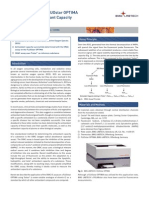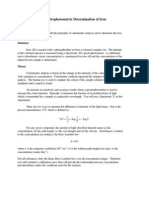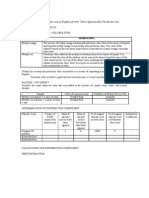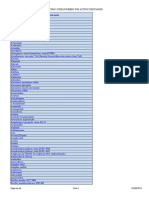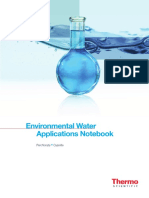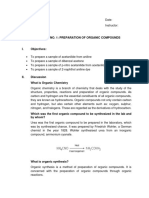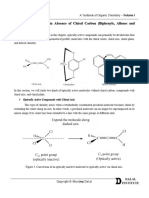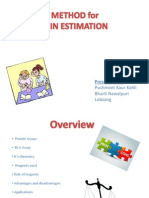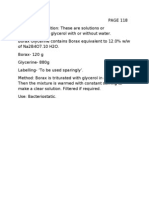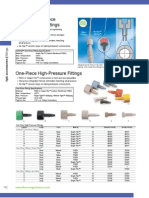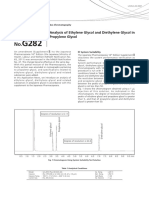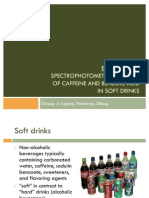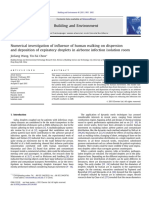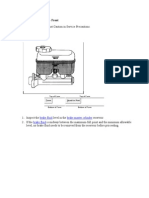Knauer - Food Preservatives
Knauer - Food Preservatives
Uploaded by
Maryanta HadisudiroCopyright:
Available Formats
Knauer - Food Preservatives
Knauer - Food Preservatives
Uploaded by
Maryanta HadisudiroCopyright
Available Formats
Share this document
Did you find this document useful?
Is this content inappropriate?
Copyright:
Available Formats
Knauer - Food Preservatives
Knauer - Food Preservatives
Uploaded by
Maryanta HadisudiroCopyright:
Available Formats
Determination of Preservatives in Foodstuffs and Cosmetics by HPLC
S. Marten, J. Harms, Knauer – ASI Advanced Scientific Instruments
Introduction:
The inspection of adherence to legal limits of With a Smartline HPLC system from Knauer, an
preservatives in foodstuffs and cosmetics can be uncomplicated and fast analysis of preservatives
performed by HPLC. The typical concentrations of can be carried out using a Eurospher 100 C8
preservatives found in directly consumable column. The Smartline UV Detector 2600 makes it
commercial foodstuffs lie around 0.1 % for sorbic possible to switch across wavelengths and
acid and benzoic acid, and around 0.05 % for para- simultaneously acquire spectrums throughout the
hydroxy benzoic acid (PHB) and PHB-ester. entire analysis. The Smartline system consists of
Determination of the preservatives found in such the Pump 1000, the multi-wavelength UV Detector
extracts is done through HPLC and subsequent UV 2600 with DAD technology, the Autosampler 3800,
detection at various wavelengths. Identification of the Manager 5000 with degasser and low pressure
the substances present is made through their gradient module and the Column Oven 4000.
spectrums and retention times. This is of advantage
because a variety of the sample's components also
absorb at 235 nm, such as artificial sweeteners and
antioxidants.
Method parameters: Calibration standard: 10 mg/L
Column: Eurospher 100, 125 x 4 mm (B7Y529)
Eluent: A: Ammonium formate buffer / methanol 50 /20
B: Ammonium formate buffer / methanol 50 /70
Gradient: 0 – 15 min: 100 % A to 100 % B
15 – 20 min: 100 % B
Flow rate: 1 ml/min
Temperature: 30 °C
Injection volume: 20 µl
Detection: UV (Smartline 2600) with wavelength
switching:
0 – 3.75 min: 255 nm Wavelength comparison
3.76 – 5.70 min: 235 nm 255 nm
5.71 – 25 min: 255 nm 235 nm
Stock solutions of each of the standards (sorbic acid,
benzoic acid, PHB, PHB-met, PHB-eth, PHB-prop,
PHB-but and 2-methoxybenzoic acid (ISTD)) were
prepared in water/methanol (60/40, v/v) at a
concentration of 1 mg/ml. The chromatographic
conditions (eluent concentration, flow rate,
temperature) were optimized in such a
way that the preservatives analyzed could
be separated as fast as possible in one
run. The concentration range for the
calibration was in the area of 10 mg/L to
50 mg/L.
Results:
All of the standards gave very good linear
calibration curves with regression
2
coefficients (r ) of 0.9998 or better. With the use
of wavelength switching, a sufficiently sensitive
detection was possible. The following detection
limits were obtained: PHB = 0.5 mg/L, 2-methoxy benzoic acid = 2.4 mg/L, benzoic acid = 1.4 mg/L, sorbic acid =
0.25 mg/L, PHB-met = 0.52 mg/L, PHB-eth = 0.57 mg/L, PHB-prop = 0.6 mg/L, and PHB-but = 0.75 mg/L. By way
of the spectrum check feature, an additional assurance of the sample values obtained was possible. This feature
is useful for confirming the identity of each preservative peak, particularly when analyzing foodstuff and cosmetic
matrices in which additional components that coelute with the preservatives of interest are common. Such
coelution can be simply detected with the peak purity function during spectrum acquisition.
You might also like
- Ayurveda A Little Book of Self CareDocument144 pagesAyurveda A Little Book of Self CareDavid Santos90% (10)
- Si 0290 PetrobookDocument150 pagesSi 0290 PetrobooklynxxNo ratings yet
- Full Report Exer 1Document8 pagesFull Report Exer 1marinella100% (1)
- Extractable Base Neutrals and AcidsDocument15 pagesExtractable Base Neutrals and AcidsTrisyan VikyNo ratings yet
- Exp - S5 - Vapour Liquid EquilibriumDocument6 pagesExp - S5 - Vapour Liquid EquilibriumAnuj SrivastavaNo ratings yet
- Case Report: PRR Using Cention N in Children's TeethDocument7 pagesCase Report: PRR Using Cention N in Children's TeethArevamadeline AegesfiNo ratings yet
- XPCIE009EN-A PSA - First InfoDocument25 pagesXPCIE009EN-A PSA - First InfoHayat ShaikhNo ratings yet
- En ASFA AU Koplík UV - VIS - SpectrometryDocument12 pagesEn ASFA AU Koplík UV - VIS - SpectrometryJedha YantiNo ratings yet
- AN148 ORAC Trolox Antioxidants Fluorescence FLUOstarDocument2 pagesAN148 ORAC Trolox Antioxidants Fluorescence FLUOstarWinne SiaNo ratings yet
- DEHP RA Report FullDocument588 pagesDEHP RA Report Fulljunyi.hjyNo ratings yet
- Fe by ColorimetricDocument6 pagesFe by ColorimetrickumarchemNo ratings yet
- APHA 4500C - Fluoride (Ion Selective Method)Document2 pagesAPHA 4500C - Fluoride (Ion Selective Method)Rizky DiniNo ratings yet
- Imine ReductionDocument4 pagesImine ReductionRatna Siti KhodijahNo ratings yet
- Partial DataDocument2 pagesPartial DataKarla CeaNo ratings yet
- Assignment 1 Atomic Absorption SpectroscDocument22 pagesAssignment 1 Atomic Absorption Spectroscpakpolitics206No ratings yet
- TG38 Version 4 December 2018Document5 pagesTG38 Version 4 December 2018Ahmad Atsari Sujud100% (1)
- FWR Expt 1 - ColorimetryDocument10 pagesFWR Expt 1 - ColorimetryMerrene Bright Divino JudanNo ratings yet
- Development and Validation of RP-HPLC Method For The Assay of Pregabalin CapsuleDocument9 pagesDevelopment and Validation of RP-HPLC Method For The Assay of Pregabalin CapsuleRubinaNo ratings yet
- Unit 3.15.02 - Sulphur Dioxide Determination by FIA (DNTB)Document14 pagesUnit 3.15.02 - Sulphur Dioxide Determination by FIA (DNTB)RiyanNo ratings yet
- 01 - Determination of Acid ValueDocument2 pages01 - Determination of Acid ValueParixit BhandurgeNo ratings yet
- Chlorophyll and Carotenoid Determination 2010Document2 pagesChlorophyll and Carotenoid Determination 2010Shahrukh Ghulam Nabi100% (1)
- Cabendazim HPLC Fase Movil Menos CargadaDocument6 pagesCabendazim HPLC Fase Movil Menos CargadaLaura GuarguatiNo ratings yet
- Gas ChromatographyDocument19 pagesGas ChromatographyNauman Mithani100% (2)
- HPLC Analysis of Vitamin CDocument1 pageHPLC Analysis of Vitamin CHuong NguyenNo ratings yet
- CIPAC - Numbers of A.IDocument30 pagesCIPAC - Numbers of A.IAmera MasuodNo ratings yet
- 5530 PhenolDocument5 pages5530 Phenolgeorgiette100% (1)
- Sugars Analysis by HPLC-RIDocument3 pagesSugars Analysis by HPLC-RISanjukta Roy100% (1)
- PolarographyDocument303 pagesPolarographyHERNANDEZ1010100% (1)
- An 70048 Environmental Water Applications Notebook AN70048 EDocument134 pagesAn 70048 Environmental Water Applications Notebook AN70048 EKALLIOPINo ratings yet
- Exp 11 ReportDocument9 pagesExp 11 ReportOh Zi YiNo ratings yet
- Codex Stan 19-1981 Amd.2013 Codex Standard For Edible Fats and Oils Not Covered by Individual Standards (5p)Document5 pagesCodex Stan 19-1981 Amd.2013 Codex Standard For Edible Fats and Oils Not Covered by Individual Standards (5p)Mark KwanNo ratings yet
- Lab No.1 - Preparation of Organic CompoundsDocument6 pagesLab No.1 - Preparation of Organic CompoundsJin-Woo SungNo ratings yet
- ATOOCV1!2!13 Optical Activity in Absence of Chiral Carbon Biphenyls Allenes and SpiranesDocument13 pagesATOOCV1!2!13 Optical Activity in Absence of Chiral Carbon Biphenyls Allenes and Spiranesvanshkhurana8077No ratings yet
- 1-Fundamentals of HPLC 2Document65 pages1-Fundamentals of HPLC 2Spinco InformaticsNo ratings yet
- HPLC TitrationDocument7 pagesHPLC TitrationMelisa MonerrisNo ratings yet
- Standard Operating Protocol For Total Phenols ContentsDocument3 pagesStandard Operating Protocol For Total Phenols ContentsdogloveracuaNo ratings yet
- Determination of PolyphenolDocument17 pagesDetermination of PolyphenolOnline NinaNo ratings yet
- BCA Method of Protein EstimationDocument31 pagesBCA Method of Protein EstimationSwetha SundarNo ratings yet
- Absorbance and Fluorescence Spectroscopies of Green Fluorescent ProteinDocument24 pagesAbsorbance and Fluorescence Spectroscopies of Green Fluorescent ProteinMadel Tutor ChaturvediNo ratings yet
- Submitted By: Kiran Naz O7-Arid-64 FT 6 SemesterDocument42 pagesSubmitted By: Kiran Naz O7-Arid-64 FT 6 SemesterKiran NiaziNo ratings yet
- Etil Hexano ASTM D1969Document2 pagesEtil Hexano ASTM D1969Coordinador LaboratorioNo ratings yet
- Skalar Methods: Analysis: Ortho Phosphate Range: 5 200 G P/liter Sample: Sea Water SANDocument6 pagesSkalar Methods: Analysis: Ortho Phosphate Range: 5 200 G P/liter Sample: Sea Water SANBruno PereiraNo ratings yet
- Borax GlycerineDocument1 pageBorax GlycerinePranshu AdityaNo ratings yet
- HPLC DetectorsDocument18 pagesHPLC DetectorssouvenirsouvenirNo ratings yet
- GC MSDocument15 pagesGC MSfahmiNo ratings yet
- Preparation and Standardization of Potassium Thiocyanate Solution Lab ActDocument5 pagesPreparation and Standardization of Potassium Thiocyanate Solution Lab ActALYSSA MAE BURACNo ratings yet
- BuLi TitrationDocument2 pagesBuLi TitrationRodary DymarcuzNo ratings yet
- Lab Report GCDocument8 pagesLab Report GCAyish MataNo ratings yet
- Chromatography - The Most Versatile Method of Chemical AnalysisDocument438 pagesChromatography - The Most Versatile Method of Chemical AnalysisdnabrasilNo ratings yet
- Hydrocortisone FormulationDocument2 pagesHydrocortisone FormulationSafrin Puji RahayuNo ratings yet
- Precolumn Fmoc HistamineDocument7 pagesPrecolumn Fmoc HistamineLaura MarcelaNo ratings yet
- HPLC Accessory AlltechDocument11 pagesHPLC Accessory AlltechBin Shen100% (1)
- Oilpac eDocument85 pagesOilpac eAri CleciusNo ratings yet
- Determination of Phosphate in WaterDocument8 pagesDetermination of Phosphate in Watersha2salaNo ratings yet
- EG DEG ShimadzuDocument2 pagesEG DEG ShimadzuSiti FatriyahNo ratings yet
- HPLC - 4Document24 pagesHPLC - 4Melisa Soledad Barco Jara100% (1)
- 04-27-01 Tartaric Acid - Quantitative MethodDocument2 pages04-27-01 Tartaric Acid - Quantitative MethodMuhammad Farhan Hidayat100% (1)
- 2 EhDocument1 page2 EhNGuyễn Văn TânNo ratings yet
- Bio-Based SolventsFrom EverandBio-Based SolventsFrançois JérômeNo ratings yet
- Phenoxyethanol-Cosmetics en PDFDocument2 pagesPhenoxyethanol-Cosmetics en PDFHiềnNo ratings yet
- 127.1 Expt 4Document28 pages127.1 Expt 4Karina Narciso100% (10)
- DOC042 53 20249 Oct16 PDFDocument7 pagesDOC042 53 20249 Oct16 PDFLinh ĐỗNo ratings yet
- S-150 Series Slip-On: S # S - 1 5 0 (A S M E)Document1 pageS-150 Series Slip-On: S # S - 1 5 0 (A S M E)Nsh AliNo ratings yet
- 4 5953781827192751296Document119 pages4 5953781827192751296Ridha Afzal100% (1)
- CE 463.3 - Advanced Structural Analysis Lab 2 - SAP2000 Truss StructuresDocument5 pagesCE 463.3 - Advanced Structural Analysis Lab 2 - SAP2000 Truss StructuresmadridcapitalNo ratings yet
- Uterine Fibroids Natural Treatment by CurcuminDocument6 pagesUterine Fibroids Natural Treatment by CurcuminRay CrashNo ratings yet
- Computer BasicsDocument47 pagesComputer BasicsRam PrasadNo ratings yet
- Metopen Ekonomi PembangunanDocument14 pagesMetopen Ekonomi PembangunanYeni NoviandiNo ratings yet
- 感覺&知覺IIIDocument49 pages感覺&知覺IIIPeter ChangNo ratings yet
- ACT Thrissur Plus Two Easy QuestionsDocument23 pagesACT Thrissur Plus Two Easy QuestionsAbin Pm100% (1)
- GPX 1126 PDocument26 pagesGPX 1126 PJose BohorquezNo ratings yet
- 1.regional Integration of South AsiaDocument2 pages1.regional Integration of South Asiaasim5595No ratings yet
- KUSAIN - NCP IN NCM 112 RLE ConstipationDocument2 pagesKUSAIN - NCP IN NCM 112 RLE Constipationjay kusainNo ratings yet
- Wind TurbineDocument7 pagesWind TurbineMayita ContrerasNo ratings yet
- BEFORE NIGHT COMES: Narrative and Gesture in Berio's Sequenza III (1966)Document10 pagesBEFORE NIGHT COMES: Narrative and Gesture in Berio's Sequenza III (1966)Elena PlazaNo ratings yet
- 水泵四折页 英文版 分页Document8 pages水泵四折页 英文版 分页Candi BaroajiNo ratings yet
- Termocupla Tipo K MurphyDocument2 pagesTermocupla Tipo K MurphyJonathan MoralesNo ratings yet
- Fluid Mechanics Mid ExamDocument5 pagesFluid Mechanics Mid ExamRalph CastilloNo ratings yet
- HX290 SM PDFDocument42 pagesHX290 SM PDFManuel Diaz GomezNo ratings yet
- Building and Environment: Jinliang Wang, Tin-Tai ChowDocument10 pagesBuilding and Environment: Jinliang Wang, Tin-Tai ChowAji FauziNo ratings yet
- 2004 Chevy Trailblazer Change Front Brake PadsDocument10 pages2004 Chevy Trailblazer Change Front Brake PadsKwkeatonNo ratings yet
- Recommendations For FRP VesselsDocument2 pagesRecommendations For FRP VesselsA. Adriano UreñaNo ratings yet
- Lab - Report - 1Document7 pagesLab - Report - 1rafinsafayatNo ratings yet
- Kandiyohi SandandgravelDocument1 pageKandiyohi SandandgravelWest Central TribuneNo ratings yet
- Autronica PC2014 EXPDocument35 pagesAutronica PC2014 EXPramonagiurgea86No ratings yet
- The Hawk and The HenDocument1 pageThe Hawk and The Henalmira villarealNo ratings yet
- Fluid Mechanics I Ecv 2201Document4 pagesFluid Mechanics I Ecv 2201fityzgaulles miyiendaNo ratings yet
- Bone Tumor: A. Nithya 1 Year M.SC (Nursing)Document46 pagesBone Tumor: A. Nithya 1 Year M.SC (Nursing)nithya nithyaNo ratings yet
- Eternity of Sound and The Science of MantrasDocument209 pagesEternity of Sound and The Science of MantrasVedic BhairavNo ratings yet








